Cowes
Images link to larger copies
- This page is devoted to
postcards and photographs of the Cowes on the Isle of Wight,
showing the piers, ferries and floating bridge.
-
- Cowes Floating
Bridge:-
- There have been eight
floating bridges at Cowes, built in 1859, 1882, 1896, 1909, 1925,
1936, 1952 and 1975. For many years two floating bridges were
maintained simultaneously, with the second (and older) bridge
used during overhauls of the main bridge. In recent years only
one bridge has been owned, with a foot passenger ferry used during
overhauls. The first bridge was owned by the Floating Bridge
Company. The 1882 and 1896 bridges were owned by the Steam Packet
Company. Subsequent bridges were ordered by the local council,
who numbered them 1 to 5, so the current bridge No.5 is the 8th
bridge on the route.
-
- A rowing boat ferry had
existed for many years at the narrow point of the River Medina,
which divides East and West Cowes on the Isle of Wight. From 1720
to 1859, the ferry rights were owned by the Roberton family.
From 1842, a pontoon had been used to to transport carts, animals
etc, the pontoon being winched across under horse power. A horse
powered winch was used at the ferry repair yard until 1973.
-
- In 1859 the Floating Bridge
Company was formed and bought the ferry rights. The first steam
ferry was built by a Mr Hodgkinson on the River Itchen at Southampton,
and service started 24th November 1859.
-
- In 1868, the ferry was
bought by the Steam Packet Company (later part of Red Funnel). They bought a new ferry in 1882
from Napier & Son of Southampton. In 1902 the bridge received
a new boiler by W. White & Sons of Vectis Yard, West Cowes. This bridge was sold for scrap
in 1909, acting as spare bridge from 1896. However the boiler
was transferred to the 1896 ferry before disposal.
-
- The 1896 bridge was built by W. White &
Sons of Vectis Yard, West Cowes.
-
- . In 1909 she received the newer
boiler from the 1882 ferry which was being withdrawn.
-
- In 1901 the West and East
Cowes Urban Councils took over the ferry. The Urban Council ordered
a new ferry from Whites in 1909 (and the 1882 ferry was sold).
The new bridge was built of steel, had power ramps and electric
lighting. As the first Council-owned bridge, it was named Bridge No.1, ignoring the three previous bridges
(including the 1896 bridge still in service as a spare). The
condition of the old 1896 bridge deteriorated during the First
World War, and was used for only two weeks a year.
-
- The 1925 Bridge No.2 was built by J. Samuel White & Co, of East
Cowes, and was the
last steam bridge. She was over 100 feet long and could carry
up to eight cars. During the Second World War she spent some
time on the
Sandbanks
Ferry. Bridge No.2 was then sold for use at Sandbanks as spare ferry in 1952 when Bridge No.4 arrived. In 1926 the Council purchased
a new yard for use as a maintenance slip. The yard was sold in
1981, and the 1983 ferry refit was done in Poole. However, the
new owners of the yard have done subsequent overhauls.
-
- The 1936 Bridge No.3 was the first to be diesel-electric
powered. All machinery was located below the car deck level,
releasing more space for passengers. She was again built by
J. Samuel White & Co, of East Cowes.
-
- Bridge No.4 was built by
J.Bolson of Poole. She entered service in 1952 and could
carry 12 cars. She was withdrawn in 1982 when Bridge No.5 was delivered, leaving no reserve
bridge for the first time in many years. Since 1992, foot passengers
have travelled for free.
-
- The current (2007) Bridge No.5 was built by Fairey Marine (East
Cowes) in 1995. It is diesel-hydraulic powered and can carry
19 cars. As the sole ferry on the route, she overtook the working
days of all previous bridges within 10 years.
-
- Sections on this Page:-
- Cowes
Floating Bridge
- Cowes
West Pier
-
- Floating Bridges on this
Page:-
- Floating
Bridge Company - 1859
- Steam
Packet Company - 1882
- Steam
Packet Company - 1896
- Bridge
No.1 - 1909
- Bridge
No.2 - 1925
- Bridge
No.3 - 1936
- Bridge
No.4 - 1952
- Bridge
No.5 - 1975
-
- Associated Pages:-
- Red
Funnel Ferries
- Isle
of Wight Piers
- Isle
of Wight Photo Diary
- UK
Excursion Ships
- Ferry
Postcards
- Cruise
Ship Postcards
- Ocean
Liner Postcards
- Simplon
Postcards - Recent Updates
- Simplon Postcards - Home Page
-
- References:-
- Discovering the
Floating Bridge at Cowes by Sarah Burdett - Island Books 1995
-
- Search This Website:-
-
powered
by
FreeFind
Cowes Floating Bridge
-
- Floating Bridge Company
- 1859
-
- In 1859 the Floating Bridge
Company was formed and bought the ferry rights. The first steam
ferry was built by a Mr Hodgkinson on the River Itchen at Southampton,
and service started 24th November 1859.
-
-
-
-
- Steam Packet Company
- 1882-1909
-
- In 1868, the ferry was
bought by the Steam Packet Company (later part of Red Funnel). They bought a new ferry in 1882
from Napier & Son of Southampton. This bridge was sold for
scrap in 1909, acting as spare bridge from 1896 when a new bridge
was built.
-
-
- Postcard
of the 1882 Cowes Floating Bridge
-
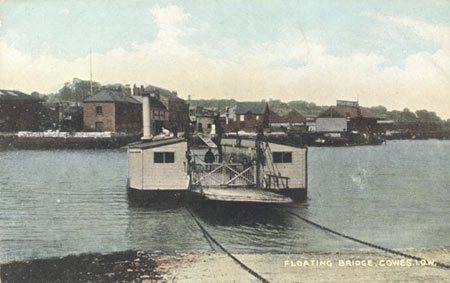
-
-
-
-
-
- Steam Packet Company
- 1896-c1925
-
- The 1896 bridge was built by W. White &
Sons of Vectis Yard, West Cowes. In 1909 she received the newer
boiler from the 1882 ferry which was being withdrawn. The ferry
was sold to yacht builder Uffa Fox around 1925, who used it as
both workshop and house.
-
-
- Postcard
of the 1896 Cowes Floating Bridge
-

-
-
- Postcard
of the 1896 Cowes Floating Bridge
-
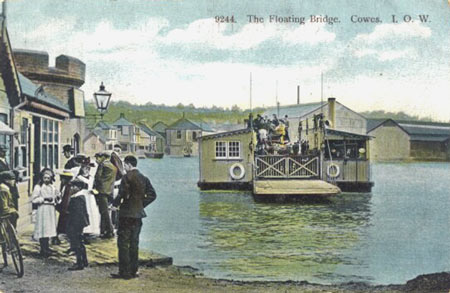
-
-
- Postcard
of the 1896 Cowes Floating Bridge
-
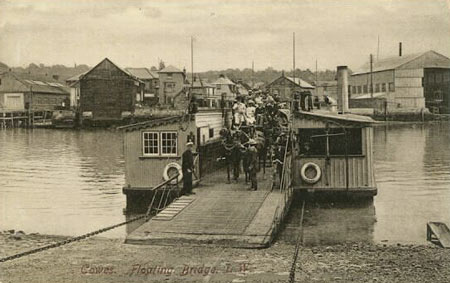
-
-
- Postcard
of the 1896 Cowes Floating Bridge
- Variation
on the card above
-
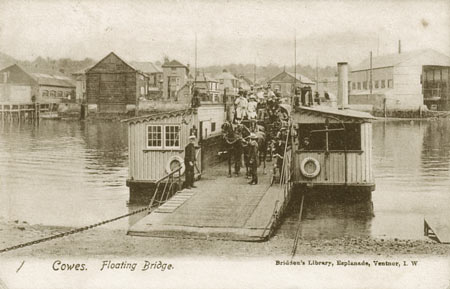
-
-
- Postcard
of the 1896 Cowes Floating Bridge
-

-
-
- Postcard
of the 1896 Cowes Floating Bridge
-
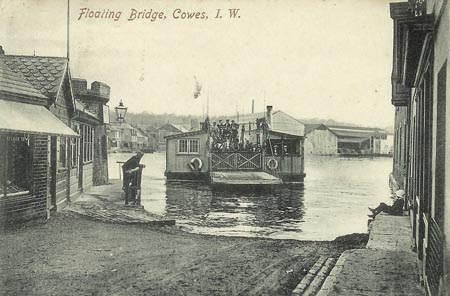
-
-
- Pamlin
postcard of the 1896 Cowes Floating Bridge
-

-
-
- Pamlin
postcard of the 1896 Cowes Floating Bridge
-
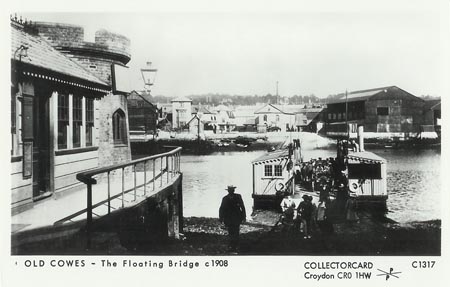
-
-
-
-
-
-
- Bridge No.1 - 1909-1936
-
- In 1901 the West and East
Cowes Urban Councils took over the ferry. The Urban Council ordered
a new ferry from W. White & Sons of Vectis Yard, West Cowes, in 1909 (and the 1882 ferry was sold).
The new bridge was built of steel, had power ramps and electric
lighting. As the first Council-owned bridge, it was named Bridge
No.1, ignoring the three previous bridges (including the 1896
bridge still in service as a spare). The condition of the old
1896 bridge deteriorated during the First World War, and was
used for only two weeks a year. The bridge was sold in 1936.
-
-
- Postcard
of the Cowes floating Bridge No.1 of 1909
-
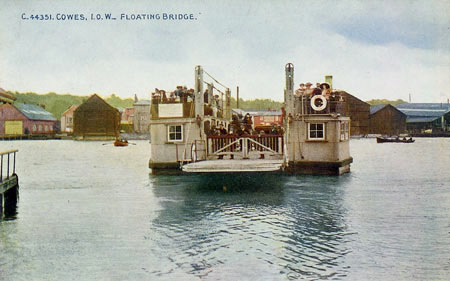
-
-
- Postcard
of the Cowes floating Bridge No.1 of 1909
- Alternative
copy of card above
-

-
-
- Postcard
of the Cowes floating Bridge No.1 of 1909
-

-
-
- Postcard
of the Cowes floating Bridge No.1 of 1909
- Different
copy of the card above
-
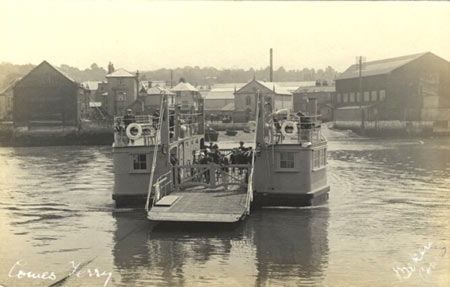
-
-
- Postcard
of the Cowes floating Bridge No.1 of 1909
-
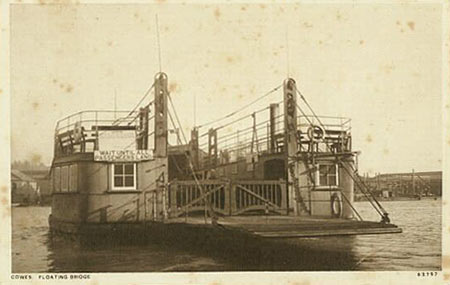
-
-
- Postcard
of the Cowes floating Bridge No.1 of 1909
-
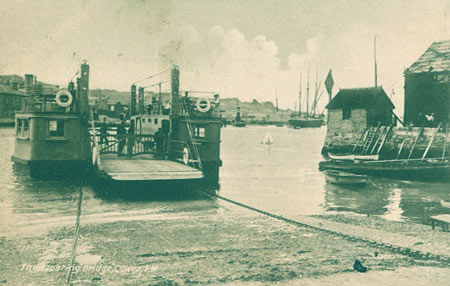
-
-
-
-
-
-
- Bridge No.2 - 1925-1952
-
- The 1925 Bridge No.2
was built by J. Samuel White & Co, of East Cowes, and was the last steam bridge. She was over
100 feet long and could carry up to eight cars. During the Second
World War she spent some time on the
Sandbanks Ferry. Bridge No.2 was then sold
for use at
Sandbanks as spare ferry in 1952 when Bridge No.4 arrived.
-
-
- Postcard
of the Cowes floating Bridge No.2 of 1925
-
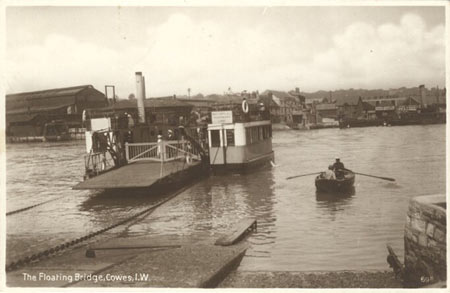
-
-
- Ferry
No.2 at Sandbanks - the only image I have found at Sandbanks
so far
-

-
-
-
-
-
-
- Bridge No.3 - 1936
-
- The 1936 Bridge No.3 was the first to be diesel-electric
powered. All machinery was located below the car deck level,
releasing more space for passengers. She was again built by J. Samuel White &
Co, of East Cowes.
-
-
- E.A.Sweetman
postcard of the Cowes floating Bridge No.3 of 1936
-
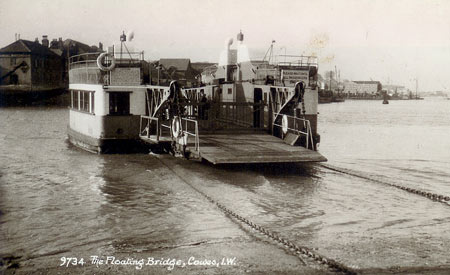
-
-
- E.A.Sweetman
postcard of the Cowes floating Bridge No.3 of 1936
- A different
copy of the card above
-
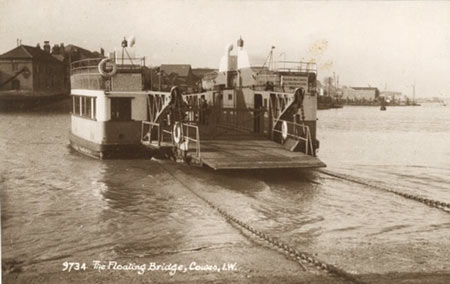
-
-
- Postcard
of the Cowes floating Bridge No.3 of 1936
-
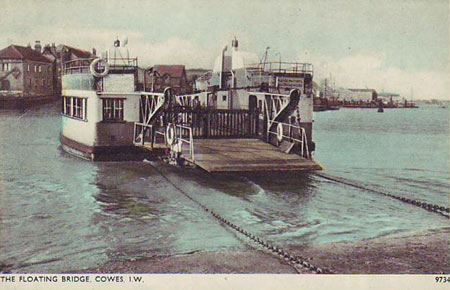
-
-
- Photo
of the Cowes floating Bridge No.3 of 1936
- Horse-powered
winch manoeuvring the ferry onto the maintenance slip - in use
until 1973
-
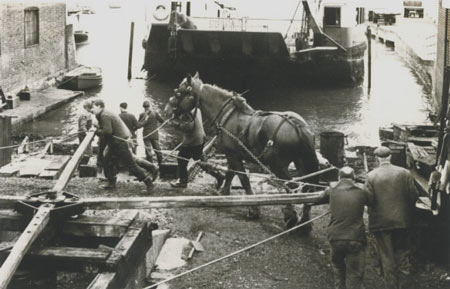
-
-
-
-
-
-
- Bridge No.4 - 1952
-
- Bridge No.4 was built by
J.Bolson of Poole. She entered service in 1952 and could
carry 12 cars. She was withdrawn in 1982 when Bridge No.5 was delivered, leaving no reserve
bridge for the first time in many years. Since 1992, foot passengers
have travelled for free.
-
-
- Postcard
of the Cowes floating Bridge No.4 of 1952
-
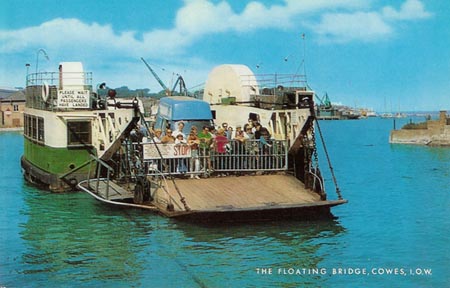
-
-
- G.Dean
& Co Bay Series postcard D828 of the Cowes floating Bridge
No.4 of 1952
-
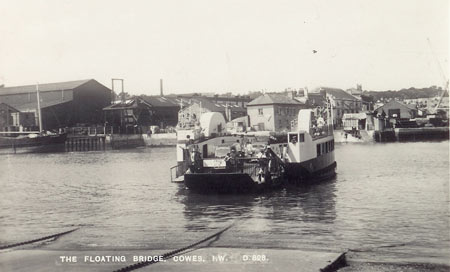
-
-
- G.Dean
& Co Bay Series postcard D828 of the Cowes floating Bridge
No.4 of 1952
- Different
image to same serial number above
-
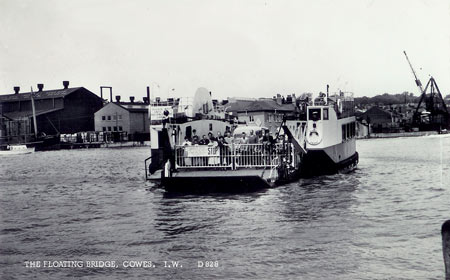
-
-
- Postcard
of the Cowes floating Bridge No.4 of 1952
- Channel
Islands ferry Sarnia or Caesarea, plus a frigate,
fitting out
-

-
-
- Photograph
of the Cowes floating Bridge No.4 of 1952
- Photo:
© Ian Boyle, May 1975
-
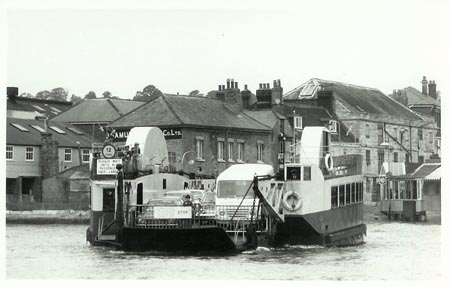
-
-
- Photograph
of the Cowes floating Bridge No.4 of 1952